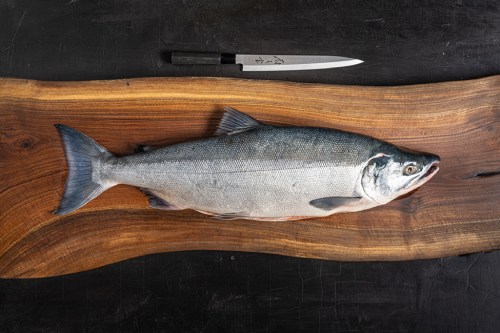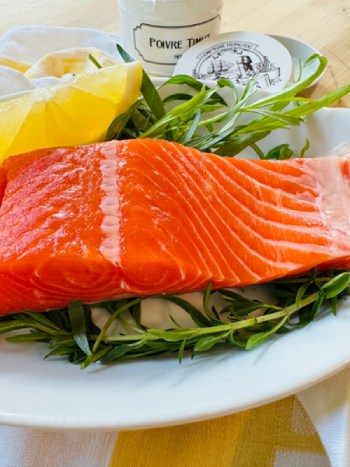By using our website, you agree to the use of cookies as described in our Cookie Policy
Questions on Deck
Simplicity Shines with Copper River Salmon: Questions on Deck!
Welcome to Questions on Deck, where we address common and basic cooking questions often heard during the salmon season.
Question: I have never been comfortable cooking fish. That said, I am trying to eat more at home but many of the recipes I find seem complicated and require a lot of specialty ingredients. Any tips?
Cooking fish, particularly Copper River salmon, can be easy and it can be fun. The trick is to start with one simple recipe such as the ones we feature in Simplicity Shines. Each recipe calls for basic seasonal ingredients that can be easily sourced and the recipes themselves feature basic cooking techniques. Try one of the basic recipes and be observant while cooking. Make some notes on what went well, what worked great, what you think could be switched up. Over time you should naturally feel more comfortable cooking salmon and being inventive based on what’s at hand or in season.
Question: Sometimes during the height of the Copper River salmon season my seafood market sells the whole sockeye at a very good price. I don’t generally buy a whole fish, but I’d like to try it. Any suggestions?
Great question and yes by all means dive in and go for it. During the height of the Copper River salmon season, many retailers feature sales, especially around the holiday weekends so it’s a great opportunity to buy.
To start, ask your fishmonger to fillet and debone the fish for you. They usually do it for free so no added cost there. They can also custom cut the fish for you. Ask the fishmonger to leave one side of the fish as a whole fillet for grilling with a group of friends. Then ask them to cut the other fillet into individual serving sizes that you can wrap tightly and freeze at home and use within a month or two. The individual fillets cook quickly and work great for midweek dinners. You could also buy the fish with a couple friends to split the cost and portion it out between all of you.

Question: Everyone talks about grilling Copper River salmon during the summer, but I don’t feel like I’ve mastered that yet. What do you recommend?
Yes, Copper River salmon is well suited to grilling because its high fat content helps to keep the fish moist and juicy. And when the fish is grilled skin side down, the skin acts as a natural vessel to capture that salmon fat as it drips out of the fillet. That said there are many opinions and techniques for grilling salmon and a lot depends on the type of grill you are using, the heat source, the distance of the rack from the heat source, and even weather conditions. Some cooks like to cook the fish on the open grill using only the bottom heat. Other cooks like to cook salmon with the lid down which cooks the fish from the bottom and the top. Then when it comes to temperature culinary camps remain divided. Some like low and slow heat whereas others go for a hot grill. The biggest factor in all of this is for a cook to learn to judge how the fish reacts to the heat and adjust accordingly. If the fillet is cooking too hot, move it to a cooler part of the grill. If it’s cooking too slow, maybe lower the lid and watch it every minute or two.
Furthermore, it’s important to know how to judge the fish for doneness. The fish is close to being done when the flesh is opaque, and the thickest part of the fillet is just starting to flake when separated with a fork.
And finally, keep in mind that the fish will continue to cook for a few minutes after it is removed from the heat.
Question: I have a very small kitchen in my apartment, and I have one of the new model toaster ovens. Can I cook fish in that?
Yes, the new toaster ovens work very well for fish. We tested these recipes in a conventional oven, and we also tested them in a Breville Smart Oven Pro, which was equally as successful. In the Breville, we had great results cooking five-to-six-ounce fillets at 400 F for about ten to 12 minutes or until the flesh was opaque and flaked easily with a fork.
 Be Bold with Herbs
Be Bold with HerbsQuestion: I like to use fresh herbs such as dill, parsley and basil when cooking fish but sometimes I have these soft herbs leftover and if I don’t use them up quickly, they wilt and go bad. I’d like to avoid that waste.
When you have fresh herbs, you can save them in multiple ways. One option is to chop them and freeze them in ice cube trays with water. Once frozen solid they can be popped out and bagged up. The herb cubes can then be tossed into melted butter to pour over your fish, or they can be incorporated into vinaigrettes. You can also save the herbs and save time by taking the fresh herb and mixing it with softened butter to create a quick compound butter that can be rolled into a log and frozen. The butter can then be sliced, and the slices can be tucked on top of hot cooked salmon to make a super easy sauce like we’ve done for a couple of our new recipes!
Question: When I read a lot of salmon recipes the instructions call for oven temperatures that range from 250 F for a slow heat cooking method to super high heat methods with temperatures over 450 F. Why is this?
Of course, many cooks have many opinions on the best temperature. The 250 F temperature is a very low temperature that will avoid overcooking your fish, but the fish will take longer to cook. A temperature of 450 F is quite hot, and we feel its easy to over cook the salmon at that temperature. In general, we call for 400 F as a good temperature but essentially you can adjust to the temperature that you are comfortable with. Just be sure to adjust cooking times accordingly as well.
Question: Some recipes call for salmon fillets, pin boned. What are pin bones and how do I get them out?
Great question. Pin bones are part of the salmon’s skeleton and can be found in the salmon fillets after the fish has been filleted. Some fishmongers pull them out, but many don’t. So, when you get the fillet home and you are preparing to cook it, you need to run your finger along the salmon fillet and feel for little bone tips. They will run in a continues line along the fillet once you find them. To avoid bruising and tearing the flesh itself while removing the bones, it’s best to use a tweezer, preferably a fish tweezer, and pull the bone out in the direction in which is it poking and do it at an angle to avoid disturbing the flesh. If the pin bones were pulled out straight up, the flesh of the salmon would get ragged and messy.
By Melissa A. Trainer


